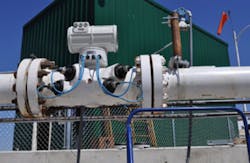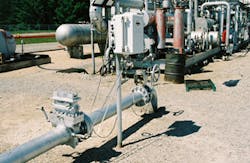Part I: Flow Trend Watch
The following is the first in a two-part series on broad-based trends in flowmeter technology and applications based on results of Flow Research’s new Volume X: The World Market for Flowmeters, 4th Edition. The focus of Part I is on new-technology flowmeters. Part II will focus on trends in traditional-technology flowmeters.
Defining New-Technology Flowmeters
New-technology flowmeters are defined by the following characteristics:
- The core technology was introduced after the end of World War II.
- They incorporate technological ad-vances that avoid some of the problems in earlier flowmeters.
- They receive more focus in terms of new product development than older technologies.
- Their performance, including criteria such as accuracy, is at a higher level than that of traditional technology flowmeters.
- They are quicker to incorporate recent advances in communication protocols such as HART, Foundation Fieldbus, and Profibus than traditional technology meters.
Generally, flowmeters that fit in the “new technology” category include Coriolis, magnetic, ultrasonic, vortex, and thermal.
Coriolis
Coriolis is the fastest growing flowmeter market, and there are a number of reasons for this. One is that Coriolis flowmeters remain the most accurate flowmeter, and they are highly reliable with little need for maintenance. Coriolis meters do not place any obstruction in the flowstream, although bent-tube meters can slow down flow velocity. Straight-tube meters have been developed to address this effect and to suit the needs of sanitary applications, which pose an issue for bent-tube meters, which can accumulate material building at their bending points.
The most important recent advance in the Coriolis market is the development of Coriolis meters for line sizes above 6 inches. Rheonik, now part of GE Measurement, used to be the only company offering large line-size Coriolis meters. In the past five years, Micro Motion, Endress+Hauser, and KROHNE have all entered this market. Many of these meters sell in the range of $75,000. They are primarily targeting oil & gas applications. Many of them, though not all, are designed for custody-transfer applications.
Coriolis meters, along with ultrasonic, are getting a substantial portion of the research & development dollars from the major flowmeter companies. As a result, a steady stream of new products and new features for existing products is entering the market. This is clearly one of the driving forces behind the rapid growth in the Coriolis flowmeter market.
Magnetic
The growth rate of the magnetic flowmeter market is not as great as that of Coriolis, but the magnetic flowmeter market is already one of the largest of any flowmeter type. This is true despite the fact that magnetic flowmeters can only measure conductive liquids. This means they cannot measure steam, gas, or hydrocarbon liquids. However, suppliers have made some progress in enabling magnetic flowmeters to measure low conductivity liquids.
Magnetic flowmeters are widely used in the chemical, food & beverage, and pharmaceutical industries. There is a wide variety of linings used for sanitary applications. PFA and PTFE are the two most popular types of liners. PTFE is a combination of fluorine and carbon that is also known as Teflon. Other popular types of liners are hard rubber, ceramic, and polyurethane. A significant percentage of magnetic flowmeters come in sizes of 1 inch or less, and they can measure very low flows.
The most popular industry for magnetic flowmeters is the water & wastewater industry. They excel at measuring any kind of water, whether clean or dirty, and can measure slurries that few other flowmeters can tolerate. For clean water, they are relatively inexpensive, although inline magnetic flowmeters can fit line sizes of 108 inches or more. These meters are quite expensive. As a result, a number of suppliers have introduced insertion meters that are not as accurate, but are significantly less expensive than their inline counterparts.
Ultrasonic
It used to be conventional to segment the ultrasonic market into transit time, Doppler, and hybrid. While this is still valid, transit-time meters have become capable of measuring many of the fluids that formerly only Doppler meters could measure, and they have cut significantly into the market share of Doppler meters. As a result, it is now more useful now to segment the ultrasonic market into inline (spoolpiece), clamp-on, and insertion.
Inline ultrasonic meters have two or more transducers embedded into the flowmeter (sensor tube) body. They are installed by cutting into a pipe and having either wafer or flange style fittings. Inline ultrasonic meters are distinguished according to whether they have single-path, dual-path, or multipath configurations, meaning three or more paths. Custody-transfer applications require three or more paths.
Ultrasonic meters for liquids are built differently than ultrasonic meters for gas. The market for inline ultrasonic meters for custody transfer of natural gas is one of the fastest growing niches in the entire flowmeter market. Companies such as Caldon (now part of Cameron) and KROHNE have also introduced ultrasonic flowmeters for custody transfer of petroleum liquids.
Clamp-on meters have the advantage of portability (though some are fixed), and are widely used for check metering. However, they cannot achieve the same accuracy levels as inline meters for several reasons. One is that they are mounted outside of a pipe and the ultrasonic signals have to go through the pipe wall. This can attenuate the signal. The amount of attenuation depends on the type of material the pipe wall is made from. Build-up on the side of the pipe wall can also have an effect on the ultrasonic signal, introducing another level of uncertainty.
Insertion ultrasonic meters are mounted in a pipe by cutting a hole in the pipe and inserting the flowmeter into the pipe. Insertion meters are significantly less expensive than inline meters because the cost of the meter body is eliminated. However, they cannot achieve the same levels of accuracy as inline meters. One of the chief applications for insertion ultrasonic meters is for measurement of stack gas and exhaust gas emissions. Here they compete with averaging Pitot tubes and thermal flowmeters.
Vortex
In many ways, vortex meters are the most versatile type of meter. They can reliably measure all types of fluids, including liquid, steam, and gas. They are somewhat more intrusive than ultrasonic meters since they require inserting a bluff body into the flowstream. This bluff body is required so that the meter can generate the required vortices whose frequency is proportional to flowrate. While the bluff body can get knocked out of position, vortex meters are far less intrusive than turbine meters or positive displacement meters.
For many years, vortex meters did not have the same types of industry approvals as differential-pressure, turbine, ultrasonic, and Coriolis meters. This changed in 2007, when the American Petroleum Institute (API) approved a draft standard for the use of vortex flowmeters for custody-transfer applications. This approval was reaffirmed in 2010. However, up to this point it does not seem to have had much impact on the measurement of petroleum liquids or gases for custody-transfer purposes. However, the draft standard has been used in the custody transfer of steam.
Vortex flowmeters offer accurate and reliable flow measurement at a competitive price. Even though vortex meters are not as accurate as Coriolis meters, many vortex meters offer accuracy readings of better than one percent, depending on fluid and application. While vortex meters are somewhat intrusive compared to magnetic and ultrasonic meters, they are much less intrusive than the orifice plates used with DP transmitters to measure flow. Pressure drop from vortex meters is minimal, since most shedder bars are relatively small in size. Vortex meters are less widely used than magnetic flowmeters, due, in part, to the fact that they were introduced nearly 20 years after magmeters.
Thermal
Thermal flowmeters are used almost exclusively for gas. For many years, they have been associated with environmental applications. In the early 1990s, multipoint thermal flowmeters were developed to handle continuous emissions monitoring (CEM). At that time, the Environmental Protection Agency (EPA) developed regulations designed to reduce the amount of sulfuric oxide (SOX) and nitrous oxide (NOX) in the air. Multipoint thermal flowmeters were developed for these applications. Multipoint averaging Pitot tubes and ultrasonic flowmeters were also used for this purpose.
While thermal flowmeters are still used today for CEM applications, they are also used for a variety of other environmental applications. Under the Obama administration, their use for flare gas, biogas, biomass, coalbed methane, and landfill gas has become more prominent. Other popular applications for thermal flowmeters include submetering, compressed air, boiler inlet, and wastewater treatment.
Many of the environmental applications for thermal meters involve insertion meters. However, inline thermal meters are also widely used for a variety of gas applications. One disadvantage of thermal flowmeters is that it is necessary to know what type of gas is being measured. Thermal flowmeters have also not achieved the accuracy levels of Coriolis or ultrasonic meters, and their accuracy is typically less than 1 percent. However, suppliers have made important strides in the areas of thermal flowmeter accuracy and reliability. Expect to see continued developments and improvements in this area for thermal flowmeters.
Jesse Yoder,Ph.D., is president of Flow Research Inc. in Wakefield, Mass., a company he founded in 1998. He has 25 years of experience as an analyst and writer in process control. Dr. Yoder specializes in flowmeters and other field devices, including pressure and temperature products. Dr. Yoder can be reached at [email protected].
For more information on Flow Research’s Volume X: The World Market for Flowmeters, 4th Edition study, visit www.floweverything.com.
Jesse Yoder
Jesse Yoder, Ph.D., is president of Flow Research Inc. He has 30 years of experience as an analyst and writer in instrumentation. Yoder holds two U.S. patents on a dual-tube meter design and is the author of "The Tao of Measurement," published by ISA. He may be reached at [email protected]. Find more information on the latest study from Flow Research, "The World Market for Gas Flow Measurement, 4th Edition," at www.gasflows.com.




